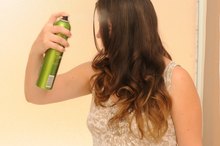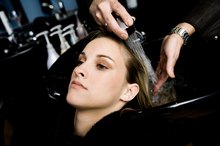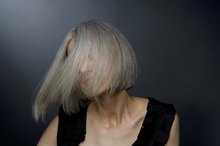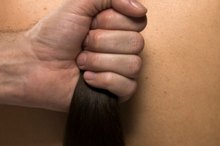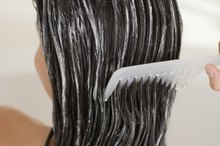Why Does Older Hair Begin to Grow in Coarse & Kinky?
Your appearance can change significantly as you get older--not always in the ways you'd expect. Many people associate aging with the appearance of fine lines and wrinkles on the face, but your hair can show your age, too. Though gray hairs are an expected part of aging, you may be surprised to find that your hair gets coarse and kinky as you get older.
The Facts
As your hair ages, it stops producing the pigments that give your hair its natural color. That's because your melanocytes--the cells in your hair that produce those pigments--slow down and ultimately halt production. As your melanocytes stop working, your hair loses its color and fades to gray, explains Roger I. Ceilley, M.D., clinical professor of dermatology at the University of Iowa in Des Moines, in "Good Housekeeping" magazine 23.
Identification
How Do You Know If Your Hair Is Healthy?
Learn More
Gray hair is different from pigmented hair in a few key ways, explains the University of Maryland Medical Center 1. Because it contains little to no melanin, gray hair is thinner and more fragile than pigmented hair. Gray hair also has a thinner cuticle than pigmented hair, which means its outer layer is easily damaged and dehydrated, making gray hair coarse and kinky.
Significance
Low melanin production also means low oil production, explains Richard Korb, a scientist in research and development at Unilever, the company that makes Dove hair care products, in "More" magazine 3. Low oil production means hair has less natural moisture, so it tends to be coarse and breakable. Because the cuticle is thinner, it can have a "wiry, won’t-lie-flat effect" on hair, says Teca Gillespie, a Pantene scientist, in "More" magazine 3.
Prevention/Solution
Does Trimming Your Hair Really Make it Grow Faster?
Learn More
You can't stop the progress of gray without dying your hair, but you can make your gray hair sleek and shiny. Use a hair serum that contains silicone that will adhere to your hair shaft, creating a smooth, protective layer around your thinned cuticle, recommends Gillespie in "More" magazine 3. Also in "More" magazine, Korb suggests a weekly at-home glossing treatment and deep conditioning session to prevent damage to thinner cuticles and to smooth coarse hair 3.
Expert Insight
Don't pluck gray hairs as they come in. Though they may be coarser than the rest of your hair, letting them grow out is the best way to deal with them, explains Louis Viel of the Miano Viel Salon in New York City in "Good Housekeeping" magazine 2. Viel says plucking the hair just means it has to grow in again, meaning the short, wiry hair will continue to stick up noticeably. If you let it grow out, though, Viel says it will have enough weight to lie flat and blend in with the rest of your hair.
- Don't pluck gray hairs as they come in.
- If you let it grow out, though, Viel says it will have enough weight to lie flat and blend in with the rest of your hair.
Related Articles
References
- University of Maryland Medical Center: Aging Changes in Hair and Nails
- Good Housekeeping Magazine: Gorgeous Gray Hair
- More Magazine: Keeping Gray Hair Healthy
- Balañá ME, Charreau HE, Leirós GJ. Epidermal stem cells and skin tissue engineering in hair follicle regeneration. World J Stem Cells. 2015;7(4):711‐727. doi:10.4252/wjsc.v7.i4.711
- Yang FC, Zhang Y, Rheinstädter MC. The structure of people's hair. PeerJ. 2014;2:e619. doi:10.7717/peerj.619
- Trüeb RM, Rezende HD, Dias MFRG. A comment on the science of hair aging. Int J Trichology. 2018;10(6):245–254. doi:10.4103/ijt.ijt_56_18
- Burg D, Yamamoto M, Namekata M, Haklani J, Koike K, Halasz M. Promotion of anagen, increased hair density and reduction of hair fall in a clinical setting following identification of FGF5-inhibiting compounds via a novel 2-stage process. Clin Cosmet Investig Dermatol. 2017;10:71–85. doi:10.2147/CCID.S123401
- Centers for Disease Control and Prevention, Agency for Toxic Substances & Disease Registry. Hair analysis panel discussion: section 2.4. Updated February 11, 2011.
- Torres F. Androgenetic, diffuse and senescent alopecia in men: practical evaluation and management. Curr Probl Dermatol. 2015;47:33-44. doi:10.1159/000369403
- Sethi A, Kaur T, Malhotra SK, Gambhir ML. Moisturizers: the slippery road. Indian J Dermatol. 2016;61(3):279‐287. doi:10.4103/0019-5154.182427
- Panhard S, Lozano I, Loussouarn G. Greying of the human hair: a worldwide survey, revisiting the '50' rule of thumb. Br J Dermatol. 2012;167(4):865–873. doi:10.1111/j.1365-2133.2012.11095.x
- Tobin DJ. Aging of the hair follicle pigmentation system. Int J Trichology. 2009;1(2):83‐93. doi:10.4103/0974-7753.58550
- Gavazzoni Dias MF. Hair cosmetics: An overview. Int J Trichology. 2015;7(1):2-15. doi:10.4103/0974-7753.153450
- Cramwell W, Sinclair R. Male androgenetic alopecia. In: Endotext. Updated February 29, 2016.
- Fortes C, Mastroeni S, Mannooranparampil TJ, Ribuffo M. The combination of overweight and smoking increases the severity of androgenetic alopecia. Int J Dermatol. 2017;56(8):862–867. doi:10.1111/ijd.13652
- Fabbrocini G, Cantelli M, Masarà A, Annunziata MC, Marasca C, Cacciapuoti S. Female pattern hair loss: A clinical, pathophysiologic, and therapeutic review. Int J Womens Dermatol. 2018;4(4):203-11. doi:10.1016/j.ijwd.2018.05.001
- Sachdeva S. Hirsutism: evaluation and treatment. Indian J Dermatol. 2010;55(1):3–7. doi:10.4103/0019-5154.60342
Writer Bio
Holly Roberts is an award-winning health and fitness writer whose work has appeared in health, lifestyle and fitness magazines. Roberts has also worked as an editor for health association publications and medical journals. She has been a professional writer for more than 10 years and holds a B.A. in English and an M.A. in literature.
